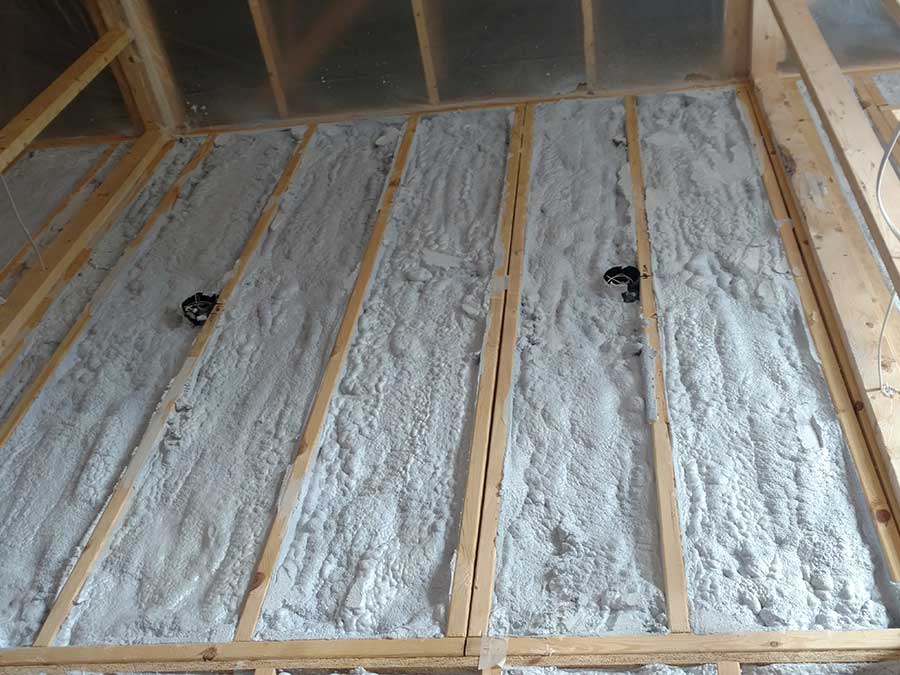Installing loose fill insulation is one of the most effective ways to boost your home’s energy efficiency in Milwaukee, WI.
Properly installed cellulose or fiberglass loose fill insulation can dramatically reduce heat loss in attics and walls, leading to lower energy bills and a more comfortable home year-round.
Follow these five steps to maximize energy savings when installing loose fill insulation.
Determine the Ideal R-Value
The R-value measures an insulation’s ability to resist heat flow. Higher R-values indicate greater insulating power.
In Milwaukee’s climate, the US Dept of Energy recommends the following R-values for loose fill:
| Area | Recommended R-Value |
|---|---|
| Attic | R49 to R60 |
| Wall Cavity | R13 to R15 |
| Floor | R25 to R30 |
Factors like your home’s age, construction, and budget also influence the ideal R-value.
Consult a professional insulation contractor to determine the optimal level for your home.

Technician applying spray foam insulation in attic space
Ensure Even Distribution
Loose fill insulation must be applied evenly to prevent gaps and settle.
Use these techniques for the best results:
- For attics, use a blowing machine with a long hose to reach all areas
- Start at the furthest corner and work back toward the attic hatch
- Hold the hose parallel to the drywall ceiling, about 18″ away
- Walk slowly to allow the insulation to flow smoothly and build up evenly
- For wall cavities, drill 1.5-2″ holes between each stud and use a fill tube
- Avoid overfilling, which can bulge the drywall or block electrical boxes
[IMAGE PLACEHOLDER: Photo demonstrating proper technique for installing loose fill insulation in an attic]
Air Seal and Minimize Leaks
Proper air sealing is critical before adding insulation. Follow this process to avoid drafts:
- Identify leaks with a visual inspection or blower door test
- Seal gaps around ducts, wires, pipes, and light fixtures with spray foam
- Caulk smaller cracks around windows, doors, and baseboards
- Cover and seal attic hatch or door
- Seal open stud cavities in attics with rigid foam board
- Check that bathroom and kitchen vents exhaust directly outside
| Leak Location | Sealing Material |
|---|---|
| Duct/pipe/wire | Spray foam |
| Window/door | Caulk |
| Open cavity | Rigid foam board |
Maximize Savings
In addition to insulation, consider these tips to boost energy efficiency:
- Upgrade to a smart or programmable thermostat
- Maintain HVAC equipment with annual tune-ups
- Switch to LED bulbs and install occupancy sensors
- Apply low-E window film to reduce heat gain
- Use ceiling fans to assist heating and cooling
A professional home energy audit can identify the most cost-effective improvements for your Milwaukee home.
Many upgrades qualify for Focus on Energy rebates.
Hire an Experienced Professional
While DIY is possible, installing loose fill insulation correctly requires skill and special equipment.
Hiring a qualified professional offers several advantages:
- Access to premium materials and commercial-grade blowers
- Expertise to determine proper R-values and air seal effectively
- Faster installation and thorough clean-up
- No exposure to dust/irritants or confined attics
- Warranty on materials and labor
Trusted insulation contractors in Milwaukee include Intec, Geis Building Products, and Milwaukee Insulation.
Check references, insurance, and Focus on Energy accreditation before hiring.
| Advantages of Pro Install | Disadvantages of DIY |
|---|---|
| Commercial-grade equipment | Rental blowers |
| Proper R-values ensured | Guesswork |
| Fast and thorough | Time-consuming |
| No irritant exposure | Dust/itch risk |
| Materials/labor warranty | No guarantee |
Why Proper Loose Fill Insulation Installation is Crucial for Milwaukee Homes
Proper installation of loose fill insulation is essential for Milwaukee homes due to several key factors:
- Climate: Milwaukee experiences cold, harsh winters with heavy snowfall and freezing temperatures. Proper insulation helps keep homes warm and comfortable while reducing the strain on heating systems.
- Energy Efficiency: With rising energy costs, Milwaukee homeowners are always looking for ways to save on their utility bills. Correctly installed loose fill insulation can significantly reduce heat loss, leading to lower energy consumption and monthly savings.
- Moisture Control: Poor insulation can lead to moisture issues like condensation, mold growth, and ice dams on roofs. These problems can cause structural damage and health hazards. Proper installation helps regulate moisture levels and prevents these costly issues.
- Soundproofing: Loose fill insulation not only thermal insulates but also absorbs sound waves. This added benefit can create a quieter, more peaceful living environment by reducing noise transmission between rooms and from outside sources like traffic or neighbors.
- Increased Home Value: A well-insulated home is more attractive to potential buyers as it offers better energy efficiency, comfort, and lower maintenance costs. Investing in professional loose fill installation can provide a solid return on investment when it comes time to sell.

Freshly installed loose fill insulation in wall cavities
However, improper installation can negate these benefits and even create new problems. Common mistakes include:
- Failing to air seal before adding insulation, allowing drafts and moisture intrusion
- Using the wrong R-value for the space, leading to inadequate thermal performance
- Uneven distribution, which creates gaps and cold spots in the insulation coverage
- Overfilling wall cavities, putting pressure on drywall and blocking electrical boxes
- Not protecting can lights, vents, and other fixtures, creating a fire hazard
To avoid these pitfalls and ensure optimal results, it’s crucial to work with experienced insulation contractors who have the knowledge, equipment, and attention to detail to get the job done right.
A professional installation will deliver the full benefits of loose fill insulation while giving you peace of mind that your Milwaukee home is well-protected against the elements.
FAQs
What is the ideal R-value for loose fill insulation in Milwaukee, WI?
For attics, the US Dept of Energy recommends R49 to R60. For walls, R13 to R15 is best. Consult a pro to determine the ideal R-value for your home.
How do you ensure even distribution of loose fill insulation?
Use a blowing machine with a long hose. Start in the farthest corner and work slowly, holding the hose parallel about 18″ from the drywall. Avoid overfilling wall cavities.
What steps can be taken to minimize air leaks and drafts during installation?
Identify and seal leaks first with spray foam, caulk, and rigid foam board. Target gaps around ducts, pipes, wires, windows, doors, open cavities, and the attic hatch.
How can installing loose fill insulation maximize energy savings in Milwaukee homes?
Loose fill can dramatically reduce heat loss through attics and walls. Combine it with air sealing, efficient HVAC, LED lighting, and low-E windows for the greatest savings.
What are the common mistakes to avoid when installing loose fill insulation?
Skipping air sealing, using the wrong R-value, overfilling walls, and not protecting vents, fans, and lights. Avoid taking on more than you can handle—leave it to a pro for best results.


